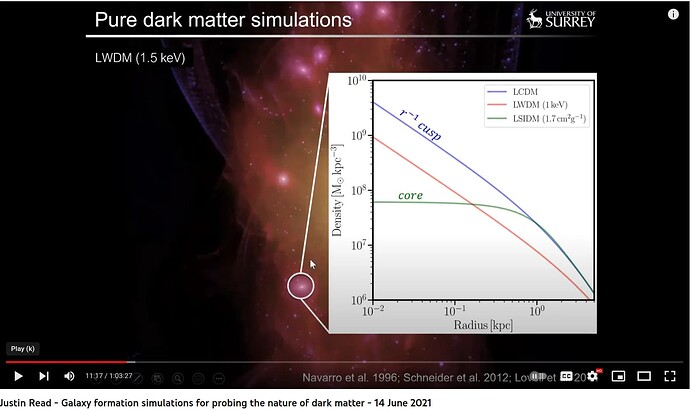In 2017, the object now named 1I/‘Oumuamua was determined to be the first unambiguously identified object on an interstellar trajectory. Intensive observation by ground- and space-based telescopes found no evidence for emission of dust and gas as is the case for comets that fall into the inner solar system from the Kuiper belt or Oort cloud. As the object receded from the Sun, its trajectory was observed to depart from that which could be explained purely by the gravitational attraction of the Sun and planets. This phenomenon is frequently observed in comets, and is readily explained by the reaction force from gas and dust emitted from the comet’s nucleus, but with no such emissions having been detected, that explanation appeared ruled out for ‘Oumuamua.
In March 2023, a paper in Nature, “Acceleration of 1I/‘Oumuamua from radiolytically produced H₂ in H₂O ice”, presented a model in which hydrogen gas liberated from water ice in the body by cosmic rays in interstellar space was released from the object when heated by the Sun. Hydrogen gas would have escaped detection by telescopic observation.
Here is the abstract:
In 2017, 1I/‘Oumuamua was identified as the first known interstellar object in the Solar System. Although typical cometary activity tracers were not detected, ‘Oumuamua showed a notable non-gravitational acceleration. So far, there has been no explanation that can reconcile these constraints. Owing to energetic considerations, outgassing of hyper-volatile molecules is favoured over heavier volatiles such as H₂O and CO₂. However, there are theoretical and/or observational inconsistencies with existing models invoking the sublimation of pure H₂, N₂ and CO. Non-outgassing explanations require fine-tuned formation mechanisms and/or unrealistic progenitor production rates. Here we report that the acceleration of ‘Oumuamua is due to the release of entrapped molecular hydrogen that formed through energetic processing of an H₂O-rich icy body. In this model, ‘Oumuamua began as an icy planetesimal that was irradiated at low temperatures by cosmic rays during its interstellar journey, and experienced warming during its passage through the Solar System. This explanation is supported by a large body of experimental work showing that H₂ is efficiently and generically produced from H₂O ice processing, and that the entrapped H₂ is released over a broad range of temperatures during annealing of the amorphous water matrix. We show that this mechanism can explain many of ‘Oumuamua’s peculiar properties without fine-tuning. This provides further support that ‘Oumuamua originated as a planetesimal relic broadly similar to Solar System comets.
In this conversation, the authors of the paper discuss the model and evidence for this explanation for one of the many anomalies of ‘Oumuamua.
In an earlier post here on 2023-03-27, “Can Hydrogen Outgassing Explain the Anomalous Acceleration of Interstellar Object 1I/‘Oumuamua?” Avi Loeb of Harvard, who argues the object may have been an artefact of an extraterrestrial technological civilisation, disputes the analysis in this paper, arguing that the hypothesis violates conservation of energy and there is no evidence for such a “dark comet” having been seen among the multitude of parabolic comets having been observed previously.
4 Likes
I wonder what excludes the possibility celestial bodies composed of a solid or quasi-liquid phase of dark matter, perhaps comprising even greater than 80% (the cosmic to ordinary matter) of the mass. In that event, a given temperature for out-gassing would enjoy a lot higher entrained mass flow thence thrust.
4 Likes
The general assumption in the currently-popular dark matter models is that the dark matter—whatever it may be—only interacts with itself and baryonic matter via the gravitational force and possibly also by the weak nuclear force, which is a very short-range force. This is why one model is called “WIMPs”, for Weakly-Interacting Massive Particles. If this is correct, then such matter would not be able to “clump” into dense solids or liquids as baryonic matter does. Solids and liquids are held together by the electromagnetic force, which dark matter does not “feel”, just as neutrinos do not. (If dark matter did interact with electromagnetism, it would not behave in ways which cause it to produce the effects in galactic rotation curves and large scale structure formation in the universe which it was introduced to explain.)
Dark matter doesn’t clump because, even though it is attracted by gravitation, without interactions other than gravity, it has no way too lose energy and settle into a gravitational well—it just passes right through and keeps on going. Baryonic matter, on the other hand, starts to lose energy by collisions when its density reaches a certain value and contracts further until electromagnetic forces kick in and cause it to condense into solid bodies.
Now, since we have no idea what dark matter is, nobody can say for sure that it doesn’t interact. Perhaps it has its own set of forces which only it feels and there’s a whole periodic table of dark matter elements—it can’t be ruled out. But if these dark matter comets were common in the universe, you’d expect that we’d have seen some already among parabolic orbit comets bound to the solar system making their first pass near the Sun.
5 Likes
The “core cusp problem” might be interpreted to mean dark matter particles collide.
Nearly all simulations form dark matter halos which have “cuspy” dark matter distributions, with density increasing steeply at small radii, while the rotation curves of most observed dwarf galaxies suggest that they have flat central dark matter density profiles (“cores”).
If dark matter particles have a finite collision cross section, as their density increases with decreasing distance to the galactic black hole, they will increasingly collide thereby scattering each other into the black hole. The result would be a flattening of the density as the distance decreases as in this simulation’s “core” curve:
An upper limit can be estimated for the collision cross-section of such a hypothetical dark matter particle. I’ve seen multiple references for a limit of approximately 2cm^2/gram. But one must be careful not to presume that cross-section is for a single particle since if dark matter has a tendency to clump, it will be misleading.
So far as I know, no one has seriously attempted to place an upper bound on the magnetic/paramagnetic/diamagnetic properties of a hypothetical dark matter particle because The Standard Model provides no room for such. This strikes me as rather strange since astronomers have bothered to place an upper bound on the collision cross-section!
4 Likes

